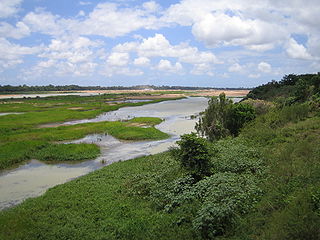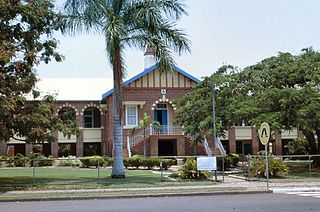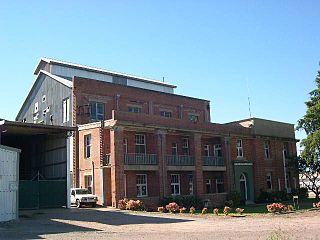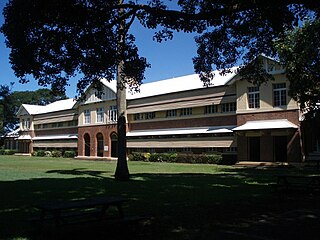
The Burdekin River is a river in North and Far North Queensland, Australia. The river rises on the northern slopes of Boulder Mountain at Valley of Lagoons, part of the western slope of the Seaview Range, and flows into the Coral Sea at Upstart Bay over 200 kilometres (124 mi) to the southeast of the source, with a catchment area of approximately 130,000 square kilometres (50,000 sq mi). The Burdekin River is Australia's largest river by (peak) discharge volume.

Ayr is a rural town and locality in the Shire of Burdekin, Queensland, Australia. It is the centre of a sugarcane-growing region and the administrative centre for the Burdekin Shire Council. In the 2016 census, the locality of Ayr had a population of 8,738 people.

Home Hill is a rural town and locality in the Shire of Burdekin, Queensland, Australia. In the 2016 census, the locality of Home Hill had a population of 2,954 people.
Brandon is a rural town and locality in the Shire of Burdekin, Queensland, Australia. In the 2016 census, Brandon had a population of 1,094 people.

Bowen Courthouse is a heritage-listed courthouse at 30 Williams Street, Bowen, Whitsunday Region, Queensland, Australia. It was designed by George St Paul Connolly of the Colonial Architect's Office and built in 1880 by Southall & Tracey. It is also known as Bowen Court House. It was added to the Queensland Heritage Register on 21 October 1992.

Innisfail Court House is a heritage-listed court house at 10 Edith Street, Innisfail, Cassowary Coast Region, Queensland, Australia. It is the town’s third court house. It was designed in the inter-war classical style by the Department of Public Works (Queensland) and built in 1939 by day labour. The current court house is a two-storeyed brick building with a corrugated-iron roof. It was added to the Queensland Heritage Register on 13 January 1995.

Ayr State High School is a heritage-listed state secondary school at 82–90 Wickham Street, Ayr, Shire of Burdekin, Queensland, Australia. It is one of three high schools in Ayr, the others being Burdekin Catholic High School and Burdekin Christian College. Ayr State High School was designed by Department of Public Works (Queensland) and built from 1935 to 1937. It was also known as Ayr State High and Intermediate School. It was added to the Queensland Heritage Register on 13 January 1995.

Home Hill Powerhouse is a heritage-listed power station at First Avenue, Home Hill, Shire of Burdekin, Queensland, Australia. It was built from c. 1921 to 1922. It is also known as Inkerman Irrigation Area Power House. It was added to the Queensland Heritage Register on 2 August 2004.

Maryborough Government Offices Building is a heritage-listed office building at 123 Wharf Street, Maryborough, Fraser Coast Region, Queensland, Australia. It was designed by Gilbert Robert Beveridge and Raymond Clare Nowland and built in 1940 by relief work. It is also known as State Government Insurance Offices and State Government Offices. It was added to the Queensland Heritage Register on 21 October 1992.

Bundaberg Police Station is a heritage-listed former court house (1882–1958) and former police station (1958–1997) at Quay Street, Bundaberg Central, Bundaberg, Bundaberg Region, Queensland, Australia. It was built from 1882 to 1958. It is also known as Bundaberg Court House. It was added to the Queensland Heritage Register on 1 December 1998.

Mackay Central State School is a heritage-listed state school at 251 Alfred Street, Mackay, Mackay Region, Queensland, Australia. It was designed by Department of Public Works (Queensland) and built in 1933. It is also known as Mackay Intermediate School. It was added to the Queensland Heritage Register on 28 July 2000.

Mackay Court House and Police Station is a heritage-listed courthouse and police station at 67 Victoria Street and 14 Brisbane Street, Mackay, Mackay Region, Queensland, Australia. They were built from 1886 to 1963. It is also known as Mackay Court House and Mackay Police Station. It was added to the Queensland Heritage Register on 21 October 1992.

Burdekin Shire Council Chambers is a heritage-listed town hall at 145 Young Street, Ayr, Shire of Burdekin, Queensland, Australia. It was designed by Frederick Smith and built in 1937 by local builder AS Wight. It is also known as Ayr Shire Council Chambers. It was added to the Queensland Heritage Register on 13 October 1997.

St Patrick's Catholic Church is a heritage-listed former Roman Catholic church at 27 Spiller Street, Brandon, Shire of Burdekin, Queensland, Australia. It was built in 1910. It is also known as Burdekin Academy of Dance. It was added to the Queensland Heritage Register on 21 October 1992.

Cyclone Leonta was a tropical cyclone that caused severe damage in North Queensland on 9 March 1903. It lasted for around twelve hours, and was the most damaging cyclone ever to hit Townsville at that time, surpassing Cyclone Sigma of 1896, with approximately 14 lives lost. It caused approximately £250,000 damage in 1903 terms.

Townsville School of Arts is a heritage-listed former school of arts and now community cultural centre at Stanley Street, Townsville CBD, City of Townsville, Queensland, Australia. It was designed by Eyre & Munro and built in 1891 by James Smith. It is also known as Dancenorth Theatre and Townsville Arts Centre. It was added to the Queensland Heritage Register on 21 October 1992.

Townsville State Government Offices is a heritage-listed office building at 12–14 Wickham Street, Townsville CBD, City of Townsville, Queensland, Australia. It was designed by Andrew Baxter Leven and built from 1935 to 1937 by relief workers. It is also known as Lands Department and Townsville Public Offices. It was added to the Queensland Heritage Register on 13 January 1995.

The Second Innisfail Court House is a heritage-listed former court house and police station in Innisfail, Cassowary Coast Region, Queensland, Australia, which was subsequently relocated and used as a private residence at 40 Buckley Street, Yorkeys Knob, Cairns Region, Queensland, Australia. It was designed by Department of Public Works (Queensland) and built from 1920 to 1930s. It is also known as the former Innisfail Police Station. It was added to the Queensland Heritage Register on 6 December 2004.

Cairns Court House Complex is a heritage-listed site incorporating a former courthouse and a former public administration building at 38–40 Abbott Street, Cairns City, Cairns, Cairns Region, Queensland, Australia. It was built from 1919 to 1921. It was added to the Queensland Heritage Register on 21 October 1992.

Ayr Post Office is a heritage-listed post office at 155 Queen Street, Ayr, Shire of Burdekin, Queensland, Australia. It was designed by the Commonwealth Department of Interior and was built in 1936. It was added to the Australian Commonwealth Heritage List on 22 August 2012.






















